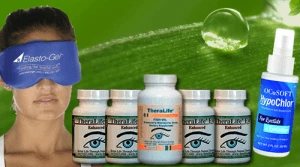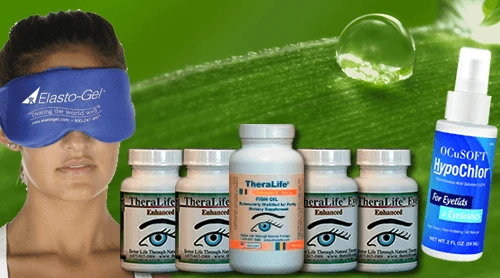Consider choosing TheraLife’s natural turmeric supplements for blepharitis, as they offer a unique and effective approach to managing this condition. TheraLife stands out as the only company that provides oral eye treatment care, specifically designed to combat ocular inflammation. The main active compound in turmeric, curcumin, is renowned for its clinically proven anti-inflammatory properties. It effectively targets the root causes of eyelid irritation and meibomian gland dysfunction by downregulating pro-inflammatory cytokines. Unlike many conventional therapies, TheraLife’s turmeric supplements provide a safe and low-risk solution without the concern of resistance or ocular toxicity. By opting for TheraLife, you’re addressing ocular inflammation at a cellular level and optimizing your eye health strategy. Explore TheraLife’s products to discover how they can benefit your eye health journey.
Best Blepharitis Treatment From TheraLife- When Drops Don’t Work.
Key Takeaways
- Turmeric’s active compound curcumin powerfully reduces inflammation, addressing a root cause of blepharitis symptoms like redness and irritation.
- Natural turmeric supplements generally have fewer side effects than conventional treatments and are well-tolerated for long-term use.
- Turmeric may help improve eyelid comfort and reduce flare-ups when combined with good eyelid hygiene.
- Turmeric’s antioxidant properties support overall eye surface health, helping restore tear film balance disrupted by blepharitis.
- Choosing high-quality turmeric supplements with enhanced bioavailability offers a safe, holistic addition to traditional blepharitis management.
Understanding Blepharitis and Its Common Symptoms
Blepharitis, an inflammatory condition affecting the eyelid margins, frequently presents with symptoms such as ocular irritation, redness, crusting, and a gritty sensation. You’ll often notice these signs worsen in the morning, and persistent cases can lead to eyelash abnormalities or recurrent styes. Common causes include bacterial colonization (typically Staphylococcus species), seborrheic dermatitis, and dysfunction of the meibomian glands. Allergic reactions and parasitic infestations, such as Demodex mites, may also contribute. Accurate identification of the underlying etiology is essential for effective management. Standard treatment options focus on eyelid hygiene, warm compresses, and topical or oral antibiotics for bacterial involvement. In some cases, anti-inflammatory medications or artificial tears may help alleviate symptoms. Early intervention can prevent complications and improve your ocular comfort. For chronic blepharitis, a multifaceted approach that includes ongoing treatment and patient education is crucial for managing the condition effectively.
The Role of Inflammation in Eye Health
Although inflammation serves as a natural defense mechanism in the body, excessive or chronic ocular inflammation disrupts the delicate homeostasis of the eye’s surface. When you struggle with blepharitis or other ocular surface diseases, pro-inflammatory cytokines and immune cells can infiltrate the eyelids and conjunctiva, leading to redness, swelling, and discomfort. Persistent inflammation may compromise the tear film and damage epithelial cells, increasing your risk for secondary infections or visual disturbances. Effective inflammation management is essential in eye care, as controlling immune responses helps restore barrier function and maintains ocular surface integrity. Omega-3 fatty acids support tear production and reduce inflammation, promoting overall eye health.
Curcumin: The Active Compound in Turmeric
Managing ocular inflammation requires targeting the underlying biological processes that drive tissue damage in blepharitis.
Curcumin, the principal bioactive compound in turmeric (Curcuma longa), exhibits potent anti-inflammatory and antioxidant properties according to clinical research. By inhibiting nuclear factor-kappa B (NF-κB) signaling and downregulating pro-inflammatory cytokine production, curcumin directly addresses the molecular pathways involved in chronic eyelid inflammation. Meibomian gland dysfunction is a primary cause of blepharitis, making it crucial to incorporate treatments that address this underlying issue. If you’re considering curcumin benefits, it’s crucial to recognize that bioavailability can be limited; consequently, formulations often combine curcumin with piperine to enhance absorption.
Evidence suggests a turmeric dosage between 500 mg to 2,000 mg of curcumin extract daily may provide therapeutic effects, but individual requirements and tolerability vary.
Always consult an eye care professional before initiating supplementation for blepharitis management.
Benefits of Turmeric for Managing Eyelid Irritation
When eyelid irritation persists, turmeric’s anti-inflammatory and antioxidant effects may help modulate local tissue responses associated with discomfort and redness. Clinical investigations suggest that curcumin, turmeric’s principal bioactive, can downregulate pro-inflammatory cytokines and oxidative stress markers in ocular tissues. By mitigating these factors, you may experience improved comfort and reduced visible signs of irritation. Integrating natural turmeric supplements at an appropriate turmeric dosage, as guided by clinical studies, may enhance these benefits without significant adverse effects. Pairing supplementation with rigorous eyelid hygiene practices enhances the overall management strategy, minimizing microbial and lipid debris that exacerbate inflammation. Considering the prevalence of MGD, turmeric supplements may support individuals experiencing symptoms associated with this condition.
Comparing Natural Turmeric Supplements to Conventional Treatments
When you compare natural turmeric supplements to conventional treatments for blepharitis, you’ll need to contemplate side effect profiles, anti-inflammatory potency, and long-term safety. Evidence suggests that turmeric may offer a favorable side effect spectrum and sustained anti-inflammatory activity compared to topical antibiotics or corticosteroids. However, you should also evaluate the limited data on turmeric’s long-term safety versus the established risk profiles of standard therapies. It’s important to consider the benefits of natural remedies for managing blepharitis, such as maintaining eyelid cleanliness and reducing flare-ups through regular care and natural treatments.
Side Effects Comparison
Although both natural turmeric supplements and conventional treatments aim to alleviate blepharitis symptoms, their side effect profiles differ markedly.
When you use conventional therapies—such as topical antibiotics, corticosteroids, or oral medications—you may encounter adverse effects like ocular irritation, increased intraocular pressure, altered tear composition, or, with prolonged use, antibiotic resistance.
In contrast, turmeric supplements generally exhibit a more favorable safety profile when manufactured under strict supplement regulations and proper turmeric sourcing.
Most evidence indicates that turmeric’s side effects are mild, typically limited to gastrointestinal discomfort or allergic reaction in sensitive individuals.
However, supplement quality can vary depending on sourcing practices and regulatory oversight, potentially impacting safety.
For addressing blepharitis, Theralife products are recommended by healthcare professionals due to their natural ingredients and significant reduction in symptoms.
Always consult your ophthalmologist before initiating any supplement regimen to ascertain compatibility with your specific health context and existing treatments.
Anti-Inflammatory Effectiveness
Understanding potential side effects is only part of evaluating a treatment’s suitability for blepharitis—assessing anti-inflammatory effectiveness is equally important.
When you compare natural remedies like turmeric supplements to conventional treatments, consider their mechanisms. Turmeric’s primary bioactive compound, curcumin, exhibits significant anti-inflammatory properties by inhibiting nuclear factor-kappa B (NF-κB) and downregulating pro-inflammatory cytokines. Clinical studies suggest curcumin can reduce ocular surface inflammation, making it a promising adjunct to standard therapies.
Conventional treatments, such as corticosteroids or antibiotic ointments, also suppress inflammation but may carry greater risks of adverse effects with prolonged use. Incorporating turmeric from dietary sources or supplements offers a natural alternative, particularly for individuals seeking to minimize exposure to synthetic pharmaceuticals.
Evidence highlights its potential, but clinical outcomes may vary based on formulation and bioavailability. Additionally, curcumin’s anti-inflammatory effects are comparable to those seen in some treatments for inflammatory conditions like uveitis.
Long-Term Use Safety
While evaluating therapies for blepharitis, it’s essential to contemplate the long-term safety profiles of both natural turmeric supplements and conventional treatments.
Conventional therapies, such as topical antibiotics or corticosteroids, may carry risks of resistance, ocular surface toxicity, or intraocular pressure elevation with prolonged use.
In contrast, natural turmeric supplements are generally well-tolerated when you adhere to established dosage guidelines, though high doses can pose hepatotoxicity or gastrointestinal disturbances over time.
Current evidence suggests that turmeric’s active compound, curcumin, demonstrates a favorable long-term safety profile, especially when compared to chronic use of steroids or antibiotics.
However, you should consult with your healthcare provider before initiating any new regimen, as individual responses and contraindications may exist, and standardized dosage guidelines for blepharitis are still under investigation.
An autoimmune diet can help reduce gut inflammation, which is significant for managing autoimmune conditions that may affect eye health, such as blepharitis.
Safety and Potential Side Effects of Turmeric Supplements
Even though turmeric supplements offer potential anti-inflammatory benefits, you should be aware of their safety profile and possible adverse effects. Adverse reactions can include gastrointestinal discomfort, nausea, or diarrhea, particularly when you exceed the recommended turmeric dosage. Rarely, high doses may elevate liver enzyme levels or interact with anticoagulant medications, increasing bleeding risk. It’s important to consult your healthcare provider before starting supplementation, especially if you have underlying health conditions or take other medications. The safety of turmeric supplements also depends on supplement sourcing. Products with inconsistent purity or contaminants could pose additional health risks. Always verify ingredient transparency and manufacturing standards to minimize exposure to adulterants. By monitoring turmeric dosage and considering supplement sourcing, you can help reduce the likelihood of adverse effects while supporting ocular health. Additionally, incorporating Omega-3 Fish Oil into your regimen might provide further benefits for eye health.
Tips for Choosing a High-Quality Turmeric Supplement
When selecting a turmeric supplement for blepharitis, you should evaluate the curcumin concentration, as this is the primary bioactive compound. Confirm the product lists purity standards and verifies the absence of contaminants. It’s also important to choose formulations that enhance curcumin bioavailability, such as those containing piperine or advanced delivery systems. Additionally, consider supplements that have undergone molecular distillation to ensure the removal of impurities and maintain high purity standards.
Check Curcumin Content
Although turmeric supplements are widely available, their therapeutic efficacy depends largely on curcumin concentration—the primary bioactive compound in turmeric.
When selecting a supplement for blepharitis, you should carefully examine the curcumin dosage listed on the product label. Clinical studies indicate that an effective curcumin dosage typically ranges from 500 mg to 1,000 mg per day, but concentrations can vary greatly across products. Low curcumin content may not provide the anti-inflammatory benefits supported by evidence.
Additionally, assess the supplement sourcing to verify the manufacturer uses high-quality turmeric with standardized curcumin levels. Reliable sourcing impacts the consistency and potency of each dose.
Opt for Purity
Because supplement purity directly influences both safety and effectiveness, you should scrutinize turmeric products for unnecessary additives, fillers, or artificial preservatives.
Select supplements that explicitly state compliance with recognized purity standards, such as Good Manufacturing Practices (GMP) or third-party certifications. These assurances indicate rigorous quality control and minimize contamination risks.
Evaluate the sourcing practices of the manufacturer; reputable brands often provide documentation regarding the origin of their turmeric and testing for heavy metals, pesticides, and microbial contaminants.
Transparent labeling and batch-specific certificates of analysis further demonstrate a commitment to purity.
Assess Absorption Methods
Even with a pure turmeric supplement, absorption efficiency determines its clinical benefit for blepharitis. Curcumin, turmeric’s active compound, exhibits inherently low bioavailability due to poor intestinal absorption and rapid metabolism.
When choosing a supplement, you must scrutinize both absorption rates and delivery methods. Some formulations include piperine (black pepper extract), which greatly enhances curcumin absorption by inhibiting its metabolic breakdown.
Other advanced delivery methods—such as phytosomal curcumin, micellar technology, or liposomal encapsulation—can further boost bioavailability, ensuring higher systemic concentrations.
Carefully read product labels and clinical data, prioritizing supplements that specify enhanced absorption rates or innovative delivery systems.
Ultimately, optimizing absorption is essential for achieving the anti-inflammatory effects needed to support blepharitis management. Don’t overlook this important aspect when selecting your turmeric supplement.
Incorporating Turmeric Into a Holistic Eye Care Routine
When developing a holistic eye care routine, you might consider the potential role of turmeric due to its bioactive compound curcumin, which demonstrates anti-inflammatory and antioxidant properties in laboratory studies. Integrating turmeric supplements as part of holistic practices can complement traditional management of blepharitis, especially when paired with dietary adjustments and ocular hygiene. Evidence suggests that systemic inflammation may exacerbate eyelid disorders, so targeting inflammation through nutrition is a logical approach.
Here’s how incorporating turmeric might impact your journey:
| Eye Comfort | Emotional Relief | Empowerment |
|---|---|---|
| Reduced itching | Less frustration | Proactive care |
| Less redness | Hope restored | Informed choices |
| Fewer flare-ups | Anxiety eased | Self-efficacy |
| Relief from pain | Optimism | Holistic growth |
| Better clarity | Peace of mind | Lasting wellness |
Always consult your ophthalmologist before adding supplements.
Best Blepharitis Treatment From TheraLife- When Drops Don’t Work.
Frequently Asked Questions
Can Turmeric Supplements Interact With Prescription Eye Medications?
You should be aware that turmeric interactions with prescription eye medication are possible.
Turmeric supplements can influence cytochrome P450 enzymes, potentially altering the metabolism of some eye drugs. This may increase or decrease therapeutic levels, affecting efficacy and side effect profiles.
Always consult your ophthalmologist or pharmacist before combining turmeric with your eye medication to guarantee safety and best treatment outcomes, since evidence-based guidance is critical in preventing adverse pharmacological interactions.
Are Turmeric Supplements Safe for Children With Blepharitis?
Imagine turmeric as a vibrant golden shield—tempting to use for your child’s blepharitis.
However, you shouldn’t administer turmeric supplements to children, especially toddlers, without direct medical supervision. Clinical evidence on toddler dosage is lacking, and the risk of potential allergies or adverse reactions is significant.
Always consult a pediatric ophthalmologist or healthcare provider before introducing any supplement, as safety and efficacy in pediatric blepharitis management remain insufficiently established.
How Long Does It Take to See Results From Turmeric Supplements?
When you start turmeric supplements, you might notice symptom improvement within 4 to 8 weeks, but results vary due to individual absorption rates and adherence to dosage guidelines.
Bioavailability of curcumin, turmeric’s active compound, is typically low, so enhanced formulations can expedite therapeutic effects.
Always follow evidence-based dosage guidelines, as higher absorption rates may accelerate anti-inflammatory benefits.
Monitor your progress and consult your healthcare provider to adjust your regimen as needed.
Can Turmeric Help With Other Eye Conditions Besides Blepharitis?
Imagine you’re using a telegraph to send your body healing signals—turmeric benefits extend beyond blepharitis.
You’ll find that curcumin, turmeric’s active compound, demonstrates anti-inflammatory and antioxidant properties in clinical studies. It may help reduce eye inflammation in conditions like conjunctivitis, uveitis, or dry eye disease.
However, you shouldn’t substitute turmeric for conventional ophthalmic treatments without consulting your eye care provider, as robust, large-scale clinical trials are still limited.
Is It Safe to Use Turmeric Supplements During Pregnancy or Breastfeeding?
When considering turmeric safety during pregnancy or breastfeeding, you should exercise caution.
Clinical evidence on pregnancy effects is limited, and high doses of turmeric supplements may stimulate uterine contractions or alter hormone levels.
While dietary turmeric appears generally safe, concentrated supplements haven’t been thoroughly studied for these populations.
Always consult your healthcare provider before starting turmeric supplements while pregnant or breastfeeding to guarantee you minimize potential risks and support ideal maternal and fetal health.
Best Blepharitis Treatment From TheraLife- When Drops Don’t Work.
Conclusion
Choosing natural turmeric supplements for blepharitis provides an effective approach to addressing inflammation, similar to illuminating a darkened space. Theralife.com offers unique oral eye treatment care, with their products specifically designed to benefit those suffering from ocular issues. Their supplements, rich in curcumin’s anti-inflammatory and antioxidant properties, aim to alleviate eyelid irritation and enhance overall eye health, complementing traditional therapies. By selecting Theralife’s high-quality products and incorporating them into your routine, you equip yourself with scientifically supported methods to relieve discomfort and foster long-term eye wellness. Consult your ophthalmologist before introducing any new supplements into your regimen.





